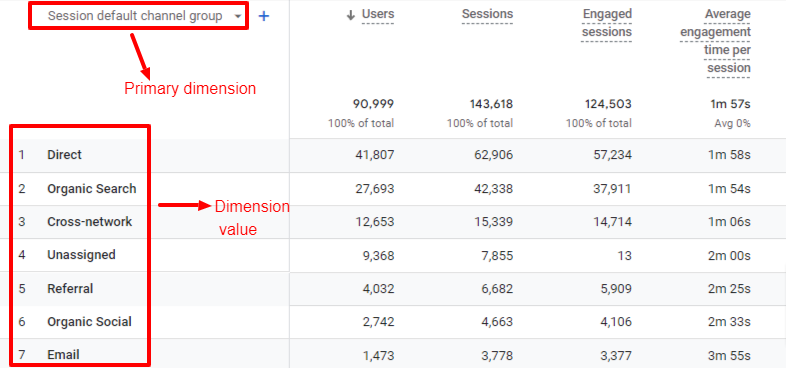The Relevance of Secondary Dimension in Google Analytics for Your search engine optimization
The Relevance of Secondary Dimension in Google Analytics for Your search engine optimization
Blog Article
Enhance Your Information Analysis Using Second Dimension in Google Analytics
Exploring the abilities of secondary measurements in Google Analytics opens up a world of opportunities for refining data evaluation. By layering additional measurements onto primary data collections, an even more detailed story emerges, losing light on individual communications and performance signs.
Recognizing Additional Dimensions
In the world of information evaluation, a vital aspect to grasp is the idea of additional measurements and their significance in extracting deeper insights from Google Analytics records. Additional measurements in Google Analytics describe additional specifications that can be included in the key measurement, enabling for an extra comprehensive evaluation of information. By incorporating additional dimensions, analysts can section and filter information to discover patterns, patterns, and relationships that could not appear when looking at the information in its entirety. These second measurements can offer context and a more thorough understanding of individual habits, website traffic resources, and other essential metrics tracked by Google Analytics.

Benefits of Using Secondary Dimensions
When assessing information in Google Analytics, the application of secondary measurements offers important insights right into customer habits and performance metrics. By adding an additional dimension to your primary data, you can dig much deeper right into the qualities of your website visitors and their communications.
Furthermore, additional dimensions enhance the context of your main information, offering a much more thorough sight of user involvement and performance metrics. Generally, the use of second measurements in Google Analytics can substantially boost the depth and high quality of your information analysis, leading to even more educated decision-making and enhanced results.
Exactly How to Include Second Measurements
By incorporating additional measurements in Google Analytics, individuals can get deeper understandings into their information analysis procedure, allowing for more comprehensive evaluation of individual behavior and efficiency metrics. Including second dimensions is a simple procedure that can significantly boost the depth of analysis. To include an additional dimension in Google Analytics, beginning by navigating to the record you intend to examine. When in the record, situate the "Second measurement" tab over the information table. Click it to expose a dropdown food selection with numerous options such as Behavior, Technology, and Custom Capacities. Select the measurement you intend to add, such as 'Source/Medium' or 'Device Category'. This secondary measurement will after that be related to your existing information, providing added context and enabling a much more in-depth analysis of individual interactions. By using second measurements successfully, customers can reveal useful understandings that might have or else been ignored, causing notified decision-making and enhanced performance strategies.
Studying Data With Second Measurements
Using find here second measurements in information analysis offers a much more detailed understanding of customer actions and efficiency metrics. By including an additional measurement to your main information embeded in Google Analytics, you can dive deeper right into the qualities of your internet site visitors and their interactions. For example, integrating the main measurement of 'source/medium' with the secondary measurement of 'landing page' can disclose which particular pages are attracting website traffic from various resources, assisting you enhance these pages for far better interaction.

Basically, evaluating data with secondary dimensions empowers you to obtain useful insights into individual behavior, recognize fads, and make notified choices to improve the efficiency of your electronic homes.
Best Practices for Additional Dimensions
In information evaluation, including secondary measurements successfully can significantly improve the deepness of understandings stemmed from metrics and customer habits patterns. When making use of additional measurements in Google Analytics or any type of other analytical device, it is critical to follow best methods to ensure the precision and importance of the information evaluation.
One secret ideal technique is to carefully choose second measurements that match the primary measurement being analyzed. Picking additional measurements that give additional context or further division can supply a much more thorough understanding of the information. It is also important to prevent overcomplicating the analysis by consisting of way too many additional dimensions, which may lead to complication or dilution of understandings.
Moreover, it is recommended to trying out various combinations of key and second dimensions to uncover new correlations and fads. Frequently assessing and improving the choice of secondary dimensions based upon the certain goals of the analysis can lead to even more workable understandings. By complying with these finest techniques, information experts can leverage secondary measurements properly to boost the general information evaluation process and decision-making capacities.

Final Thought
Finally, integrating secondary dimensions in Google Analytics is important for a comprehensive data evaluation method. By leveraging secondary dimensions together with key ones, marketing experts and experts can discover beneficial understandings and relationships that can inform decision-making and maximize electronic advertising methods. Comprehending just how to efficiently make use of secondary measurements and following finest techniques will permit professionals to draw out purposeful information and boost their total efficiency metrics.
Additional measurements in Google Analytics refer to added criteria that can be included to the primary dimension, allowing for a more comprehensive evaluation of information. By integrating additional dimensions, experts can segment and filter data to uncover patterns, fads, and relationships that may not be evident when looking at the data as a whole. Integrating the primary dimension of 'source/medium' with the second measurement of 'touchdown web page' can reveal which certain read what he said web pages are drawing in web traffic from different sources, aiding you maximize these pages for much better engagement.
One key finest practice is to thoroughly choose secondary measurements that enhance the primary measurement being analyzed. By complying with these best practices, information analysts can leverage additional measurements efficiently to improve the general data evaluation procedure and decision-making abilities.
Report this page